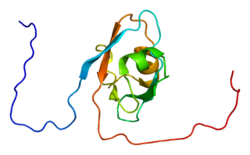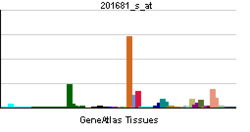- DLG5
-
Discs, large homolog 5 (Drosophila) 
PDB rendering based on 1uit.Available structures PDB 1uit Identifiers Symbols DLG5; KIAA0583; LP-DLG; P-DLG5; PDLG External IDs OMIM: 604090 MGI: 1918478 HomoloGene: 3486 GeneCards: DLG5 Gene Gene Ontology Molecular function • beta-catenin binding
• cytoskeletal protein binding
• receptor signaling complex scaffold activityCellular component • intracellular
• cytoplasm
• plasma membrane
• cell junctionBiological process • signal transduction
• negative regulation of cell proliferation
• cell-cell adhesion
• intracellular signal transduction
• regulation of apoptosisSources: Amigo / QuickGO RNA expression pattern 
More reference expression data Orthologs Species Human Mouse Entrez 9231 71228 Ensembl ENSG00000151208 ENSMUSG00000021782 UniProt Q8TDM6 n/a RefSeq (mRNA) NM_004747 XM_907765 RefSeq (protein) NP_004738 XP_912858 Location (UCSC) Chr 10:
79.55 – 79.69 MbChr 14:
24.95 – 25.07 MbPubMed search [1] [2] Disks large homolog 5 is a protein that in humans is encoded by the DLG5 gene.[1][2]
This gene encodes a member of the family of discs large (DLG) homologs, a subset of the membrane-associated guanylate kinase (MAGUK) superfamily. The MAGUK proteins are composed of a catalytically inactive guanylate kinase domain, in addition to PDZ and SH3 domains, and are thought to function as scaffolding molecules at sites of cell-cell contact. The protein encoded by this gene localizes to the plasma membrane and cytoplasm, and interacts with components of adherens junctions and the cytoskeleton. It is proposed to function in the transmission of extracellular signals to the cytoskeleton and in the maintenance of epithelial cell structure. Alternative splice variants have been described but their biological nature has not been determined.[2]
Interactions
DLG5 has been shown to interact with SORBS3.[3]
References
- ^ Nakamura H, Sudo T, Tsuiki H, Miyake H, Morisaki T, Sasaki J, Masuko N, Kochi M, Ushio Y, Saya H (Sep 1998). "Identification of a novel human homolog of the Drosophila dlg, P-dlg, specifically expressed in the gland tissues and interacting with p55". FEBS Lett 433 (1-2): 63–7. doi:10.1016/S0014-5793(98)00882-5. PMID 9738934.
- ^ a b "Entrez Gene: DLG5 discs, large homolog 5 (Drosophila)". http://www.ncbi.nlm.nih.gov/sites/entrez?Db=gene&Cmd=ShowDetailView&TermToSearch=9231.
- ^ Wakabayashi, Makoto; Ito Takuya, Mitsushima Masaru, Aizawa Sanae, Ueda Kazumitsu, Amachi Teruo, Kioka Noriyuki (Jun. 2003). "Interaction of lp-dlg/KIAA0583, a membrane-associated guanylate kinase family protein, with vinexin and beta-catenin at sites of cell-cell contact". J. Biol. Chem. (United States) 278 (24): 21709–14. doi:10.1074/jbc.M211004200. ISSN 0021-9258. PMID 12657639.
Further reading
- Newman B, Siminovitch KA (2005). "Recent advances in the genetics of inflammatory bowel disease.". Curr. Opin. Gastroenterol. 21 (4): 401–7. PMID 15930978.
- Funke L, Dakoji S, Bredt DS (2005). "Membrane-associated guanylate kinases regulate adhesion and plasticity at cell junctions.". Annu. Rev. Biochem. 74 (1): 219–45. doi:10.1146/annurev.biochem.74.082803.133339. PMID 15952887.
- Friedrichs F, Stoll M (2006). "Role of discs large homolog 5.". World J. Gastroenterol. 12 (23): 3651–6. PMID 16773680.
- Nagase T, Ishikawa K, Miyajima N, et al. (1998). "Prediction of the coding sequences of unidentified human genes. IX. The complete sequences of 100 new cDNA clones from brain which can code for large proteins in vitro.". DNA Res. 5 (1): 31–9. doi:10.1093/dnares/5.1.31. PMID 9628581.
- Bowles KR, Abraham SE, Brugada R, et al. (2000). "Construction of a high-resolution physical map of the chromosome 10q22-q23 dilated cardiomyopathy locus and analysis of candidate genes.". Genomics 67 (2): 109–27. doi:10.1006/geno.2000.6242. PMID 10903836.
- Shah G, Brugada R, Gonzalez O, et al. (2003). "The cloning, genomic organization and tissue expression profile of the human DLG5 gene.". BMC Genomics 3: 6. doi:10.1186/1471-2164-3-6. PMC 77411. PMID 11876824. http://www.pubmedcentral.nih.gov/articlerender.fcgi?tool=pmcentrez&artid=77411.
- Purmonen S, Ahola TM, Pennanen P, et al. (2002). "HDLG5/KIAA0583, encoding a MAGUK-family protein, is a primary progesterone target gene in breast cancer cells.". Int. J. Cancer 102 (1): 1–6. doi:10.1002/ijc.10665. PMID 12353226.
- Strausberg RL, Feingold EA, Grouse LH, et al. (2003). "Generation and initial analysis of more than 15,000 full-length human and mouse cDNA sequences.". Proc. Natl. Acad. Sci. U.S.A. 99 (26): 16899–903. doi:10.1073/pnas.242603899. PMC 139241. PMID 12477932. http://www.pubmedcentral.nih.gov/articlerender.fcgi?tool=pmcentrez&artid=139241.
- Wakabayashi M, Ito T, Mitsushima M, et al. (2003). "Interaction of lp-dlg/KIAA0583, a membrane-associated guanylate kinase family protein, with vinexin and beta-catenin at sites of cell-cell contact.". J. Biol. Chem. 278 (24): 21709–14. doi:10.1074/jbc.M211004200. PMID 12657639.
- Ota T, Suzuki Y, Nishikawa T, et al. (2004). "Complete sequencing and characterization of 21,243 full-length human cDNAs.". Nat. Genet. 36 (1): 40–5. doi:10.1038/ng1285. PMID 14702039.
- Stoll M, Corneliussen B, Costello CM, et al. (2004). "Genetic variation in DLG5 is associated with inflammatory bowel disease.". Nat. Genet. 36 (5): 476–80. doi:10.1038/ng1345. PMID 15107852.
- Deloukas P, Earthrowl ME, Grafham DV, et al. (2004). "The DNA sequence and comparative analysis of human chromosome 10.". Nature 429 (6990): 375–81. doi:10.1038/nature02462. PMID 15164054.
- Gerhard DS, Wagner L, Feingold EA, et al. (2004). "The status, quality, and expansion of the NIH full-length cDNA project: the Mammalian Gene Collection (MGC).". Genome Res. 14 (10B): 2121–7. doi:10.1101/gr.2596504. PMC 528928. PMID 15489334. http://www.pubmedcentral.nih.gov/articlerender.fcgi?tool=pmcentrez&artid=528928.
- Taniuchi K, Nakagawa H, Nakamura T, et al. (2005). "Down-regulation of RAB6KIFL/KIF20A, a kinesin involved with membrane trafficking of discs large homologue 5, can attenuate growth of pancreatic cancer cell.". Cancer Res. 65 (1): 105–12. PMID 15665285.
- Daly MJ, Pearce AV, Farwell L, et al. (2005). "Association of DLG5 R30Q variant with inflammatory bowel disease.". Eur. J. Hum. Genet. 13 (7): 835–9. doi:10.1038/sj.ejhg.5201403. PMID 15841097.
- Tenesa A, Noble C, Satsangi J, Dunlop M (2006). "Association of DLG5 and inflammatory bowel disease across populations.". Eur. J. Hum. Genet. 14 (3): 259–60; author reply 260–1. doi:10.1038/sj.ejhg.5201516. PMID 16391570.
- Gazouli M, Mantzaris G, Archimandritis AJ, et al. (2006). "Single nucleotide polymorphisms of OCTN1, OCTN2, and DLG5 genes in Greek patients with Crohn's disease.". World J. Gastroenterol. 11 (47): 7525–30. PMID 16437728.
PDB gallery Categories:- Human proteins
- Chromosome 10 gene stubs
Wikimedia Foundation. 2010.

